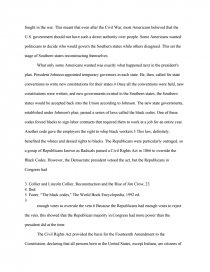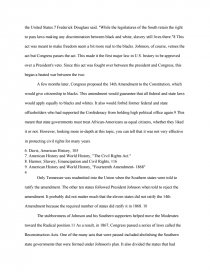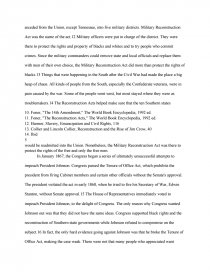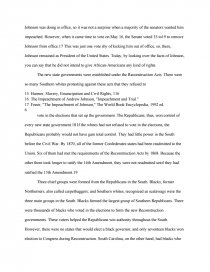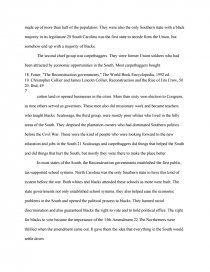The Ordeal of Reconstruction
Essay by review • February 9, 2011 • Research Paper • 2,075 Words (9 Pages) • 1,957 Views
The Civil War left a devastating nation, a crisis that would take years to overcome. The South, by all means, was wounded the most from the war. Reconstruction lasted from 1865 to 1877 and was one of the most controversial periods in the nation's history. The victory of the North in the Civil War put an end to slavery and stopped the South's effort to secede from the Union. This also marked the beginning of rebuilding the South. There would be about four million freed slaves, most of them homeless, poor, and illiterate during the era of Reconstruction.
The Presidential Reconstruction was a complicated situation because of the assassination of Lincoln on April 14, 1865. It moved Vice President Andrew Johnson into the presidency, who made sure that he did not have the same priority as the Republicans to remake the South.1 He believed that secession was a conspiracy of slaveholding aristocrats against the interests of ordinary Southerners. For that reason, Johnson created the Reconstruction plans. It sought after pardons granted to those taking a loyalty oath, no pardons be available to high Confederate officials and persons owning property valued in excess of $20,000, a state needing to abolish slavery before being readmitted, and a state requirement to repeal its secession ordinance before being readmitted.2 His plans did not offer blacks a role in the development of Reconstruction. Therefore, the Southern states had to determine where their place would be. In the same year, Johnson adopted Lincoln's lenient "10 percent plan" for Southern Reconstruction, but made significant changes to it. While changing the number 10 to 50 percent requirement for states to rejoin the Union when they take the oath of loyalty to the Union,
1. Reconstruction (U.S. history), "Presidential Reconstruction."
2. Collier and Lincoln Collier, Reconstruction and the Rise of Jim Crow, 21
2
he also required the states to ratify the Thirteenth Amendment to the Constitution which would abolish slavery.3 However, Johnson did not favor giving any kind of vote to black Americans. This approach was tolerable to a large number of Northerners, including those that fought in the war. This meant that even after the Civil War, most Americans believed that the U.S. government should not have such a direct authority over people. Some Americans wanted politicians to decide who would govern the Southern states while others disagreed. This set the stage of Southern states reconstructing themselves.
What only some Americans wanted was exactly what happened next in the president's plan. President Johnson appointed temporary governors in each state. He, then, called for state conventions to write new constitutions for their states.4 Once all the conventions were held, new constitutions were written, and new governments existed in the Southern states, the Southern states would be accepted back into the Union according to Johnson. The new state governments, established under Johnson's plan, passed a series of laws called the black codes. One of these codes forced blacks to sign labor contracts that required them to work at a job for an entire year. Another code gave the employers the right to whip black workers.5 This law, definitely, benefited the whites and denied rights to blacks. The Republicans were particularly outraged, so a group of Republicans known as Radicals passed a Civil Rights Act in 1866 to override the Black Codes. However, the Democratic president vetoed the act, but the Republicans in Congress had
3. Collier and Lincoln Collier, Reconstruction and the Rise of Jim Crow, 23
4. Ibid.
5. Foner, "The black codes," The World Book Encyclopedia, 1992 ed.
3
enough votes to overrule the veto.6 Because the Republicans had enough votes to reject the veto, this showed that the Republican majority in Congress had more power than the president did at the time.
The Civil Rights Act provided the basis for the Fourteenth Amendment to the Constitution, declaring that all persons born in the United States, except Indians, are citizens of the United States.7 Frederick Douglass said, "While the legislatures of the South retain the right to pass laws making any discrimination between black and white, slavery still lives there."8 This act was meant to make freedom seem a bit more real to the blacks. Johnson, of course, vetoes the act but Congress passes the act. This made it the first major law in U.S. history to be approved over a President's veto. Since this act was fought over between the president and Congress, this began a heated war between the two.
A few months later, Congress proposed the 14th Amendment to the Constitution, which would give citizenship to blacks. This amendment would guarantee that all federal and state laws would apply equally to blacks and whites. It also would forbid former federal and state officeholders who had supported the Confederacy from holding high political office again.9 This meant that state governments must treat African-Americans as equal citizens, whether they liked it or not. However, looking more in-depth at this topic, you can tell that it was not very effective in protecting civil rights for many years.
6. Davis, American History, 105
7. American History and World History, "The Civil Rights Act."
8. Harmer, Slavery, Emancipation and Civil Rights, 116
9. American History and World History, "Fourteenth Amendment- 1868"
4
Only Tennessee was readmitted into the Union when the Southern states were told to ratify the amendment. The other ten states followed President Johnson when told to reject the amendment. It probably did not matter much that the eleven states did not ratify the 14th Amendment because the required number of states did ratify it in 1868. 10
The stubbornness of Johnson and his Southern supporters helped move the Moderates toward the Radical position.11 As a result, in 1867, Congress passed a series of laws called the Reconstruction Acts. One of the many acts that were passed included abolishing the Southern state governments that were formed under Johnson's plan. It also divided the states that had seceded from the Union, except Tennessee, into five military districts. Military Reconstruction Act was the name of the act.12 Military officers were put in charge of the district. They were there to protect the rights
...
...

